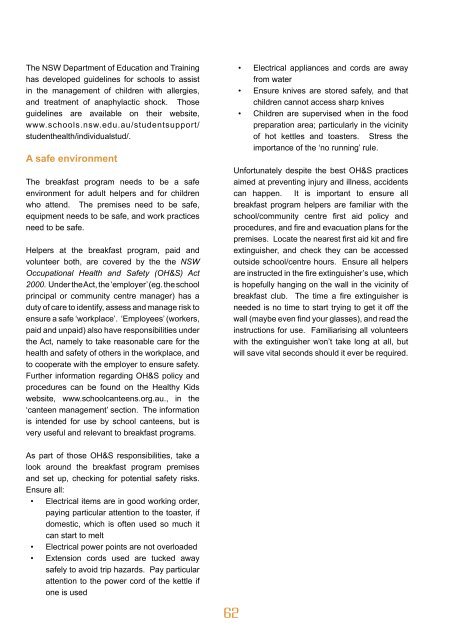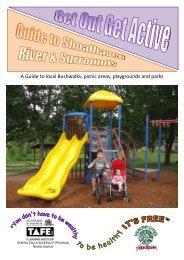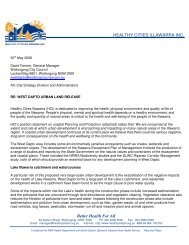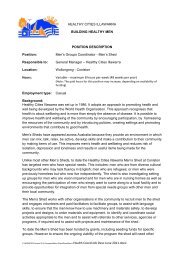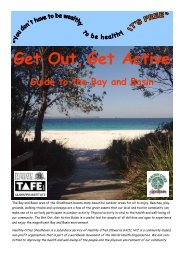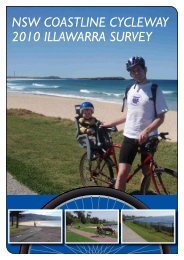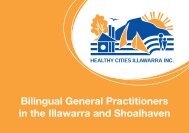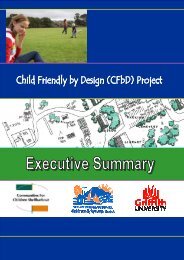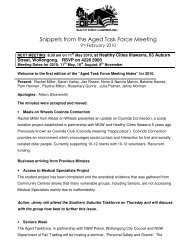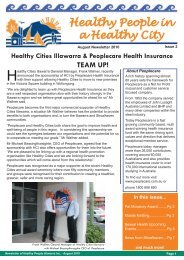here - Healthy Cities Illawarra
here - Healthy Cities Illawarra
here - Healthy Cities Illawarra
You also want an ePaper? Increase the reach of your titles
YUMPU automatically turns print PDFs into web optimized ePapers that Google loves.
The NSW Department of Education and Training<br />
has developed guidelines for schools to assist<br />
in the management of children with allergies,<br />
and treatment of anaphylactic shock. Those<br />
guidelines are available on their website,<br />
www.schools.nsw.edu.au/studentsupport/<br />
studenthealth/individualstud/.<br />
A safe environment<br />
The breakfast program needs to be a safe<br />
environment for adult helpers and for children<br />
who attend. The premises need to be safe,<br />
equipment needs to be safe, and work practices<br />
need to be safe.<br />
Helpers at the breakfast program, paid and<br />
volunteer both, are covered by the the NSW<br />
Occupational Health and Safety (OH&S) Act<br />
2000. Under the Act, the ‘employer’ (eg. the school<br />
principal or community centre manager) has a<br />
duty of care to identify, assess and manage risk to<br />
ensure a safe ‘workplace’. ‘Employees’ (workers,<br />
paid and unpaid) also have responsibilities under<br />
the Act, namely to take reasonable care for the<br />
health and safety of others in the workplace, and<br />
to cooperate with the employer to ensure safety.<br />
Further information regarding OH&S policy and<br />
procedures can be found on the <strong>Healthy</strong> Kids<br />
website, www.schoolcanteens.org.au., in the<br />
‘canteen management’ section. The information<br />
is intended for use by school canteens, but is<br />
very useful and relevant to breakfast programs.<br />
• Electrical appliances and cords are away<br />
from water<br />
• Ensure knives are stored safely, and that<br />
children cannot access sharp knives<br />
• Children are supervised when in the food<br />
preparation area; particularly in the vicinity<br />
of hot kettles and toasters. Stress the<br />
importance of the ‘no running’ rule.<br />
Unfortunately despite the best OH&S practices<br />
aimed at preventing injury and illness, accidents<br />
can happen. It is important to ensure all<br />
breakfast program helpers are familiar with the<br />
school/community centre first aid policy and<br />
procedures, and fire and evacuation plans for the<br />
premises. Locate the nearest first aid kit and fire<br />
extinguisher, and check they can be accessed<br />
outside school/centre hours. Ensure all helpers<br />
are instructed in the fire extinguisher’s use, which<br />
is hopefully hanging on the wall in the vicinity of<br />
breakfast club. The time a fire extinguisher is<br />
needed is no time to start trying to get it off the<br />
wall (maybe even find your glasses), and read the<br />
instructions for use. Familiarising all volunteers<br />
with the extinguisher won’t take long at all, but<br />
will save vital seconds should it ever be required.<br />
As part of those OH&S responsibilities, take a<br />
look around the breakfast program premises<br />
and set up, checking for potential safety risks.<br />
Ensure all:<br />
• Electrical items are in good working order,<br />
paying particular attention to the toaster, if<br />
domestic, which is often used so much it<br />
can start to melt<br />
• Electrical power points are not overloaded<br />
• Extension cords used are tucked away<br />
safely to avoid trip hazards. Pay particular<br />
attention to the power cord of the kettle if<br />
one is used<br />
62


